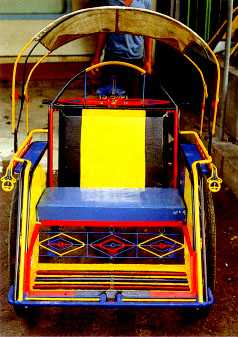
TRAVEL
NOTES
Colourful
Becak in Tulungagung
 |
|
A
number of possible routes lead from Yogyakarta and Surakarta (Solo)
to East Java. The fastest and busiest follows the course of the
Solo River, through Sragen and on to Ngawi, passing to the north
of Mt Lawu. A southern route from Solo skirts the south side of
the mountain and leads to Ponorogo. A third possibility, but only
for strong motors, is the scenic mountain pass, which winds up through
Tawangmangu and crosses the border at Cemara Sewu. From here the
road descends to the picturesque lake resort of Sarangan and continues
to Magetan and Madiun.
We chose the fourth possibility, the southern route from Yogyakarta,
which passes through Wonosari and across the arid region of Gunung
kidul (the southern mountains). The border crossing is at Donorejo,
a village famous for its agate cutting tradition. Stone working
and polishing is a popular home industry here, since the raw
material is in plentiful supply. Large lumps of unworked agate,
quartz and other semiprecious stone can be seen on display outside
the numerous small production centres. The exact age of this
craft is impossible to determine, but there is good reason to
believe that it stretches back for millennia. Stone tools along
with other evidence of human settlement dating from at least
10,000 B.C. have been discovered in the nearby coastal district
of Pacitan, suggesting that the craftsmen of Donorejo may possess
one of the longest continuous artistic traditions known to mankind. |
Besides agate
cutting, Donorejo is also well known as one of the last surviving
centres for an ancient form of the wayang theatre. Wayang beber
is related to the popular wayang kulit, or Javanese shadow play.
Instead of using the flat,
leather puppets, however, the dalang, or puppetmaster, narrates
a wayang story painted on a long scroll, rather like reading
a comic strip. The scroll is unrolled slowly, one scene at a
time. Characters and events gradually come into view on the right
hand side of the picture, while the 'past' is rolled up on the
left. The dalang sings the narrative and plays the part of each
character.As a living art, wayang beber has all but vanished
today, proficient dalang being probably a rarer species than
the Javanese tiger. Some ancient scrolls, however, may still
be seen at Donorejo. Considered sacred, they may only be opened
at certain times, following the performance of a special ritual.Before
descending to Pacitan Bay, where we were to spend the night,
we stopped to visit Tabuhan Cave, where for a small fee guides
displayed their musical talents, using the natural stalagmites
as instruments, producing strange, unearthly melodies, not unlike
the music of the gamelan.
|
